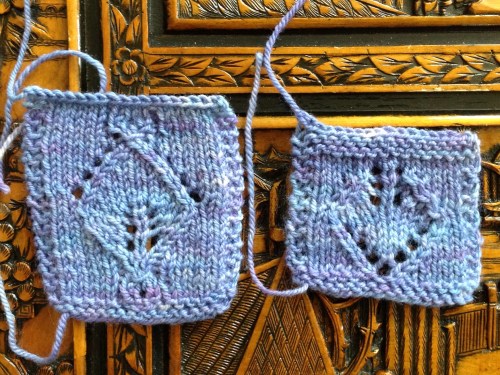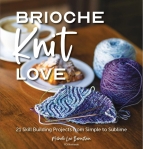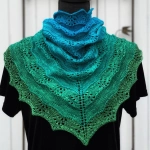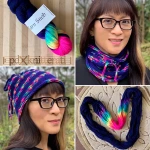Another Madrona Fiber Arts Festival has come and gone. As usual, it was wonderful. This is a picture heavy post, and the pictures are only barely edited, but I want to get this out before I jump into the Rose City Yarn Crawl, which starts on Thursday! I’ll be at For Yarn’s Sake all day Thursday sharing a trunk show with indie dyer Lorajean Kelley of Knitted Wit and designers Debbi Stone and Shannon Squire. Come say hi!
I took two classes at Madrona this year, and they were oddly related. The first was double knitting with Lucy Neatby. Double knitting involves working a double sided fabric that can look different on each side. The result is a squishy thick warm fabric.
We worked this sample in the round. On the left you can see the front and back sides of the outside of my circular knitting. On the right is the inside, which in this case is a mirror image of the outside that’s shown on the left. But it doesn’t have to be, as you can see from the lower edge. We started with some ribbing, then moved into double knitting with one color (the white) on the inside and outside, and then moved to two colors. A logical progression.
Here’s an example of one of Lucy’s pieces; the inside and the outside aren’t exact mirror images. Her color choices are exquisite, too.
One side thing that was interesting was exploring how conventional purl stitches take more yarn than knit stitches, because the yarn travels diagonally across the needle instead of parallel to it. (Pythagorean theorem, hypotenuse!) This could cause your inside and outside fabrics to grow at different rates. In this case, using the Eastern combined knitting style would give a more even fabric and no “rowing out” on the purl rows. That makes sense.
But you could also purposely make the inside and outside fabrics grow at different rates; you can do more rows on one or the other and come up with some interesting corrugation. I’m looking forward to exploring that more, later. Thanks to Lucy for a really fun and thought provoking class!
The second class I took was brioche knitting with JC Briar. I’vve been meaning to try brioche for over a year, and signing up for a class meant that I was really going to do it!
Brioche is also two sided knitting, and really squishy. This is the front and back of my class piece. We started out with single color brioche, and then moved on to two color brioche. I had tried single color brioche earlier this year, so that part was easy.
Adding a second color meant thinking a lot harder! When worked flat, it means working each row twice, first with one color, and then the other. You always start with color A when both yarns are at the same end. If they’re not at the same end, you need to catch up color B to color A. I found that it was easier for me to read my knitting than to read the written instructions. I hope that doesn’t come back to bite me later!
The addition of increases and decreases (which must be done two at a time) makes gorgeously striking patterns in brioche. You can see from my class sample that I barely started them, but they’re working. They really cause the width to suck in!
JC’s handout shows what standard charting looks like; it’s not well suited for brioche. She also charted the classwork with her non-grid Stitch Maps system, which made it clear which stitches flowed into which stitches. It’s not really set up for brioche yet, but it was very helpful for class. Registration to use Stitch Maps is free, and a basic subscription is only $15/year, so I’m going to go ahead and sign up. I do love charts, and this could be a very helpful next step.
This scarf pattern is in our handout, and I’ll be working at least part of it to try to perfect my 2 color brioche technique. I enjoyed this class, and just wish it had been an hour longer! Or all day…
I also taught three classes at Madrona. My students were all great; they came well prepared and eager to learn. Rock stars! I taught a class on one of my favorite knitting techniques, knitting with elongated novelty stitches. We knit up this little sampler in class, using double and triple wrapped stitches and manipulating them into interesting patterns. These little gems can really dress up your stockinette!
I taught a mini-class on the novelty stitch in my Tridacna Cowl.
Katey showed me her completed edging the next day. Nice work!
And I taught my blocking mini-class again. I love this class because it gets hands on, and really makes a case for blocking! (Photo by Gail Wasberg)
But Madrona isn’t just classes. There’s hang out time with other knitters/crocheters/spinners all over the hotel, and there are free demonstrations and workshops in the rotunda. The teacher talent show for charity helped raise over $12,000. And the market…
I came home with two treasures. The first is a little dish from Charan Sachar of Creative with Clay. He makes beautiful things, and I couldn’t resist. His vases and mugs are also whimsically lovely, like little cardigans complete with buttons.
The second treasure is a skein of red yarn from Abstract Fiber. I compared this red across four yarn bases, and the gray undertone of the yak base made this Lotus fingering (20/60/20 Yak/SW Merino/Silk) an even more perfect match for my red boots. I’m knitting another Zephyr because my sister really wants one!
Carla McCoy from Pocket Wheels is a great spinning teacher. This is post-banquet; Anne Berk (Annetarsia) is getting her first treadling lesson. I’ve only spun on a drop spindle; I figured Anne could try this out. But the next day I tried it in the Pocket Wheel booth, and suddenly I was making yarn. So cool! And the little wheel fits in a tote bag.
Madrona is a place where complete strangers help untangle each other’s yarn. This did get resolved, in about 20 minutes. Miraculous. The yarn was actually left over from these slippers, designed by Mary Scott Huff and worn by the happy knitter.
I found that Sally Melville has a love for boots too. Check these out:
I’m going to close this post with more pictures to tide you over until next year. See you at Madrona?
 Franklin Habit as photo bomber. Kilroy?
Franklin Habit as photo bomber. Kilroy?
 When Galina comes over to help you choose your tahkli spindle. “This one dances too much!” With Pamela Grossman and Dusty the wonder pup.
When Galina comes over to help you choose your tahkli spindle. “This one dances too much!” With Pamela Grossman and Dusty the wonder pup.
 Weaving shuttles by Joel Grinstead
Weaving shuttles by Joel Grinstead

















































































